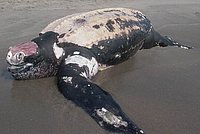Clean Ocean Advocate, September 2004
500-Pound, 70 Year Old Leatherback Found Dead in Long Branch
Cause of Death Unknown
On August 2, COA received a call from a concerned citizen about a large sea turtle found dead on a beach in Long Branch. COA’s Education Coordinator Julie Hajdusek went to the scene to investigate. Scott Longfield, a volunteer of the Marine Mammal Stranding Center (MMSC) in Brigantine, photographed and identified the turtle as a leatherback turtle, the largest species of sea turtles and endangered. The male turtle measured 55 inches long, weighed about 500 pounds, and was estimated to be 70 years old.
It was initially thought that the turtle died from attempting to eat a plastic bag because a plastic-like substance was protruding from both ends of the turtle.
Upon close inspection of the photos, the director of MMSC, Bob Schoelkopf, determined that the plastic-like substance was actually part of the turtle’s internal anatomy, the mucous lining, which was decomposing -- not a plastic bag as was originally thought.
Plastic bags floating in the ocean are commonly mistaken by sea turtles for jellyfish, the staple of their diets, and are therefore very dangerous in the marine environment. Once ingested, plastic cannot be broken down by the turtle’s digestive system. It can create a blockage in the digestive tract, often leading to the turtle’s death from starvation or digestive complications.
This was the third sea turtle to wash up dead on New Jersey’s beaches this year, which is about average for turtle wash-ups. The common causes of injury or death to sea turtles are ingestion of plastics, entanglement with commercial fishing gear, or impact by ships. Sea turtles can also become tangled in fishing nets, or inadvertently hooked on fishing lines. If they are held underwater by nets or fishing lines, they will drown. Often, entangled or hooked turtles are released by the fishermen that caught them, only to die later from their injuries.
The cause of this turtle’s death is unknown as it was not studied post-mortem.
Clean Ocean Advocate, September 2004
AN OCEAN OF PLASTICS...
| Leatherback sea turtles:
|



